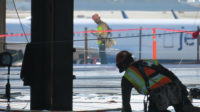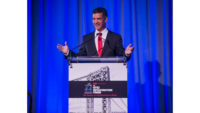New York's New Gateway: The Overhaul of John F. Kennedy International Airport
August 8, 2024
New York's New Gateway: The Overhaul of John F. Kennedy International Airport
August 8, 2024The new Terminal One at JFK airport represents the largest P3 in U.S. aviation history.
Photo courtesy Port Authority of NY and NJ
On the cusp of the 70th anniversary of the originally named New York Airport’s opening in Queens, N.Y., a blue-ribbon panel in 2017 released a report to the governor of New York: The facility, once popularly known as Idlewild Airport, needed a comprehensive master plan and a total transformation. In the seven years since, builders at John F. Kennedy International Airport have been anything but idle, and the speed at which that $19-billion transformation of the roads and terminals is occurring could be called wild.
“The evolution of JFK’s terminal buildings has been a history of separate projects with private airlines or private terminal operators designing and building individual terminals ... with no overall master plan to guide development. As a result, today’s Airport is fragmented,” according to the report, “A Vision Plan for John F. Kennedy International Airport.” It continued: “All future terminal expansion and redevelopment projects should be planned with a focus on interconnection with other terminals to enable JFK to grow over time into an integrated airport experience.”

A gubernatorial advisory group’s report in 2017 launched a concerted effort to transform JFK airport.
Photo by Scott Blair/ENR
Despite the pandemic, that growth has been swift. A $400-million expansion of Terminal 8 and a $1.5-billion expansion of Terminal 4, anchored by American Airlines and Delta Air Lines, respectively, are complete. The $9.5-billion New Terminal One (NTO)—the largest private-public partnership in the country—reached a milestone this spring with the topping out of the headhouse for the 2.6-million-sq-ft facility. Gates at NTO and in a $4.2-billion project to upgrade Terminal 6 are scheduled to open by 2026, and a $1.2-billion project to revamp the airport’s road network and build a new ground transportation center is expected to finish in 2027, all within 10 years of the vision plan’s release.
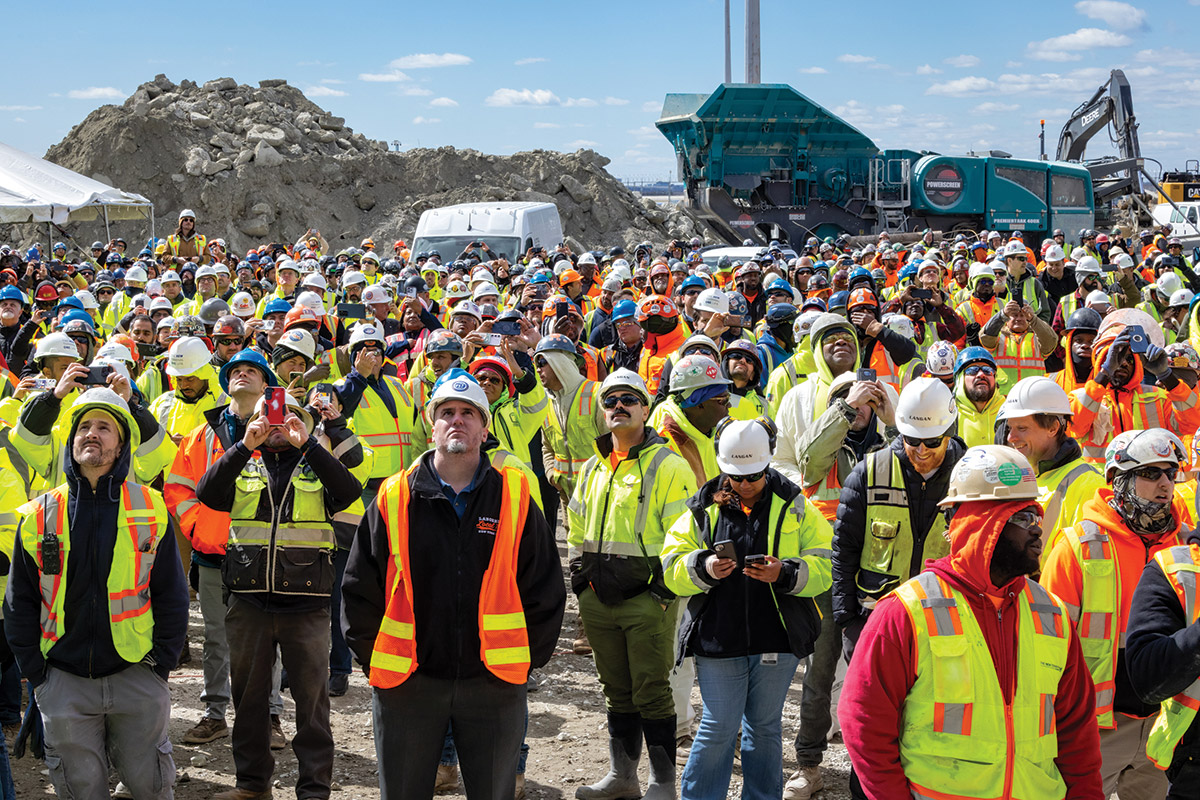
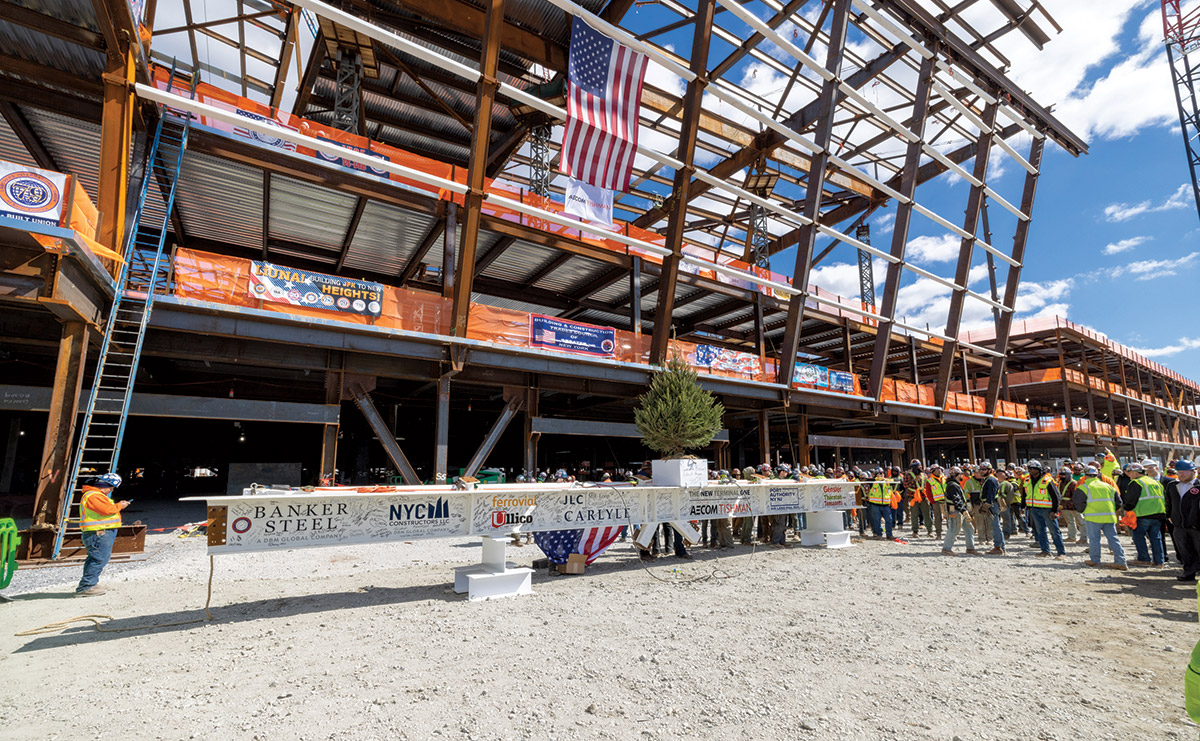
Hundreds of workers watched as the New Terminal One reached its highest point during the topping out ceremony this spring.
Photos by Andres Otero/NTO
The redevelopment of the nearly 5,000-acre campus builds on the experience of the Port Authority of New York and New Jersey with a $2.7-billion upgrade of Terminal A at Newark Liberty International Airport (ENR 7/6-14/20, ENR NYNE p. 40) and an $8-billion effort at LaGuardia International Airport that transformed Terminal B and the Delta terminal (ENR 10/26-11/2/20, p. 12). “The fact that we know the port authority makes it a lot easier,” says Luis Delgado, president of construction management at STV, which with LiRo Engineers and Tectonic Engineering & Surveying Consultants is providing construction management services for the JFK redevelopment on behalf of the port authority. “There is a continuity of the partnership” from STV’s previous work at LaGuardia, he says.
The goal is the same: “To make New York and New Jersey airports among the best in the world,” says Rick Cotton, Port Authority executive director. For LaGuardia and JFK, “we want the customer experience to be world class and have a sense of place focused on New York.” Moreover, he adds, the upgrades must help the agency’s net-zero by 2050 goal, and “the minority/women-owned business representation should reflect the diversity of Queens.” That latter goal is reflected in the agency’s 30% M/DBE and local hire requirements for all projects.
The port authority is investing $3.9 billion in the JFK redevelopment while private partners fund $15 billion, he adds. “Our private partners bring financing leverage hitting about five to one for every dollar we put in.”
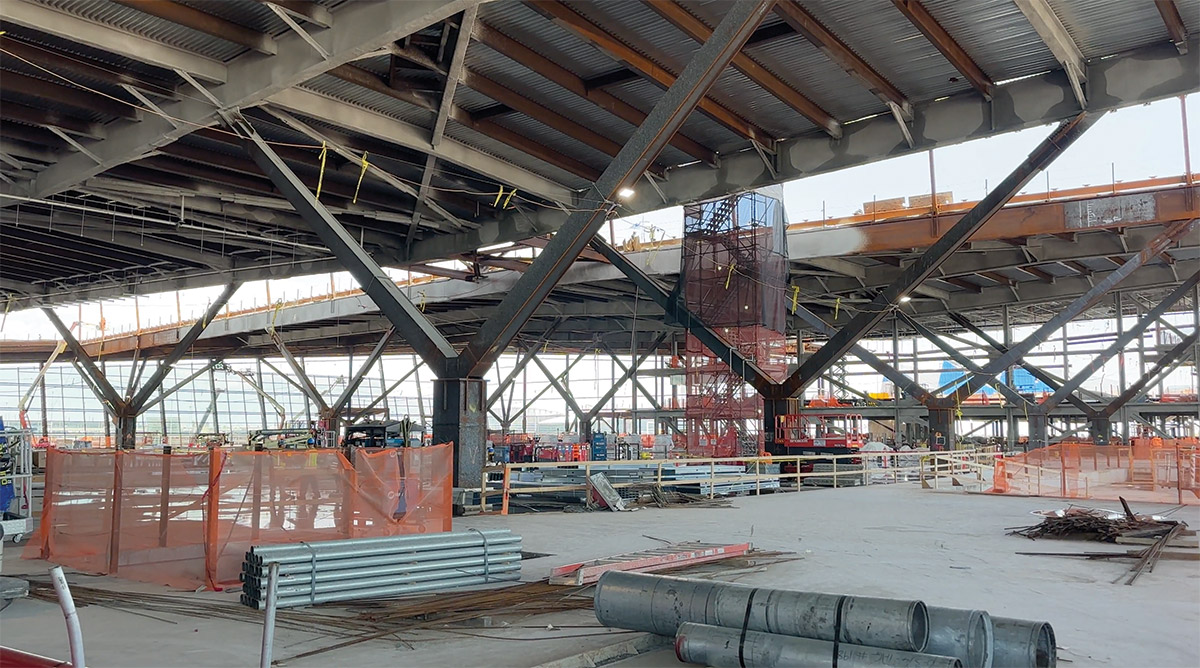
Photo by Scott Blair/ENR
Photo courtesy of PANYNJ
Photo by Scott Blair/ENR
NTO’s vast space will include greenery, concessions and sweeping views of New York.
The P3 deals were scheduled to close in spring of 2020, right when the pandemic hit, Cotton recalls. “Every one had to be totally renegotiated. None of the private partners were prepared to simply close on terms that were negotiated pre-pandemic.”
After a two-year hiatus while deals were renegotiated, the roadway package costs increased by some 25%, and Delta Air Lines’ T4 program was modified, notes Cotton. However, the scopes of Terminals 1 and 6 didn’t change substantially, he adds. By 2022, “we could see that air travel was recovering. That emboldened the confidence of developers that building capacity was [still] a good investment.”
American Airlines had already funded and started work on Terminal 8 in 2020 and, with construction manager Holt Construction, kept going on a five-gate, 70,400-sq-ft expansion and 57,500 sq ft of refurbished space. The new facility enabled British Airways to move from Terminal 7, which will be demolished to make room for the new T6’s second phase. Unibail-Rodamco-Westfield Airports last year began work on a $125-million concessions redevelopment program that will include a “great hall” hosting more than 60 new shopping and restaurant offerings at T8.
In 2021, the port authority and Delta revised a $3.8-billion plan into a $1.5-billion, 10-gate, 150,000-sq-ft concourse extension at T4, while demolishing Terminal 2 and renovating the T4 arrivals and departures hall. “With the uncertainties, we had to rethink our expansion,” says Roel Huinink, president and CEO of JFKIAT, the operator of Terminal 4.
In two years, Delta and its construction partners built an updated check-in and baggage drop area with digitized signage, expanded security checkpoints and domestic baggage claim, and added new restrooms and Delta’s Digital ID biometric facial matching technology. The airline consolidated its operations into the new T4 in early 2023 while opening a 14,000-sq-ft lounge later that year.
In June this year, Delta opened its largest lounge ever, designed by Gensler. At 39,000 sq ft, it features a full-service brasserie, market and wellness area. “We will in the future further enhance the passenger experience” by upgrading hold rooms and building new concession areas representing NYC boroughs, says Huinink. “We will finish what we started.”
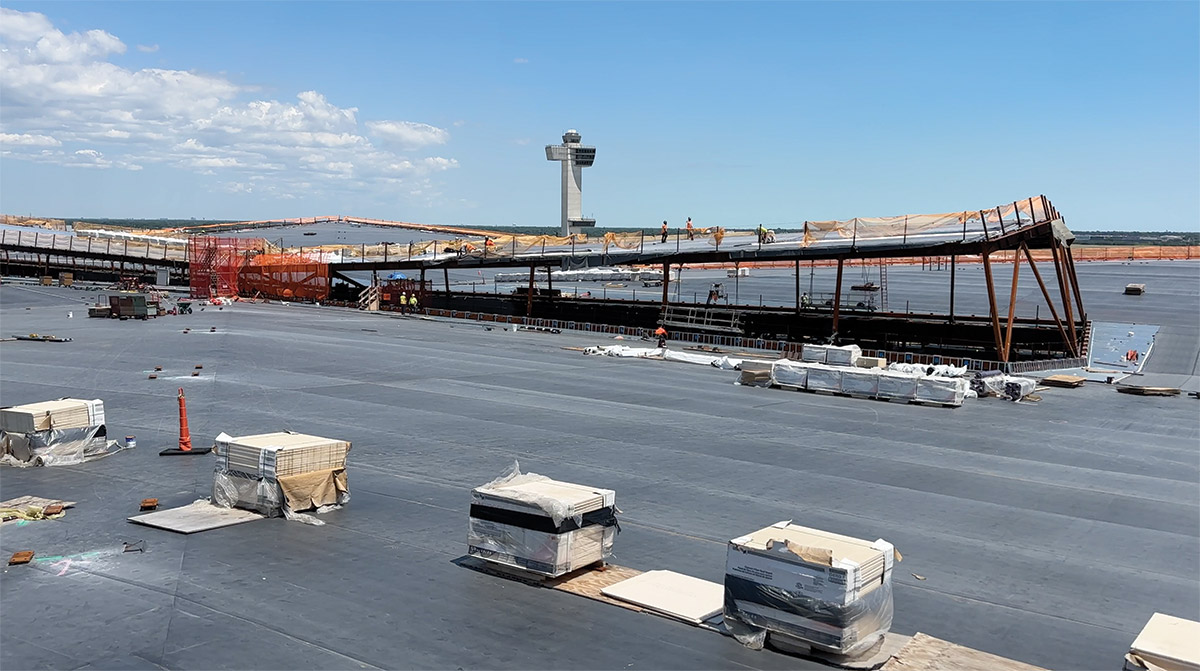
Photo by Scott Blair/ENR

The campus-wide transformation is taking place while JFK airport continues to handle traffic.
Photo courtesy of Vantage Group
Tying It Together
At most U.S. airports, the $4.2-billion, 1.2-million sq ft new Terminal 6 would be the largest on site. JFK Millennium Partners (JMP) is building T6 in two phases, with the first five gates to open in 2026.
“We broke ground here back in January of 2023,” says Billy Racky, senior vice president field operations with AECOM Hunt, the contractor. The team spent the first several months dealing with old utilities and foundations left from the former Sundrome Terminal, demolished in 2011. “There were abandoned duct banks, hydrant fuel lines and lots of old utilities to contend with while driving piles.” The terminal sits on some 1,600 tapered tube piles approximately 80 ft deep.
The team partitioned the site into more than 20 sections for steel sequences and eight zones for overhead mechanical-electric-plumbing work, says Racky. This fall, the team expects to top out the terminal and install an 80-ft oculus that will be—along with a second, 40-ft oculus—an architectural highlight. The terminal will also have more than 2,000 solar panels.
After Phase 1 reaches substantial completion, estimated for December 2025, “we will demolish T7 and continue building T6 to the west” with five more gates to open in 2028, says Racky.
AECOM Hunt is also building 2.6 miles of a three-level roadway system. “So the challenges for us in this small acreage was that we had to handle the Terminal 5 traffic and the Airtrain, because you need a permit to excavate close to the Airtrain,” says Fazal Bangash, JMP civil site manager. “It took about a year of coordination to get this real estate available so that we can drive piles, pile caps, wing walls, columns and roads.” The team also has to accommodate traffic to and from T5, anchored by JetBlue and eventually connecting directly to T6.
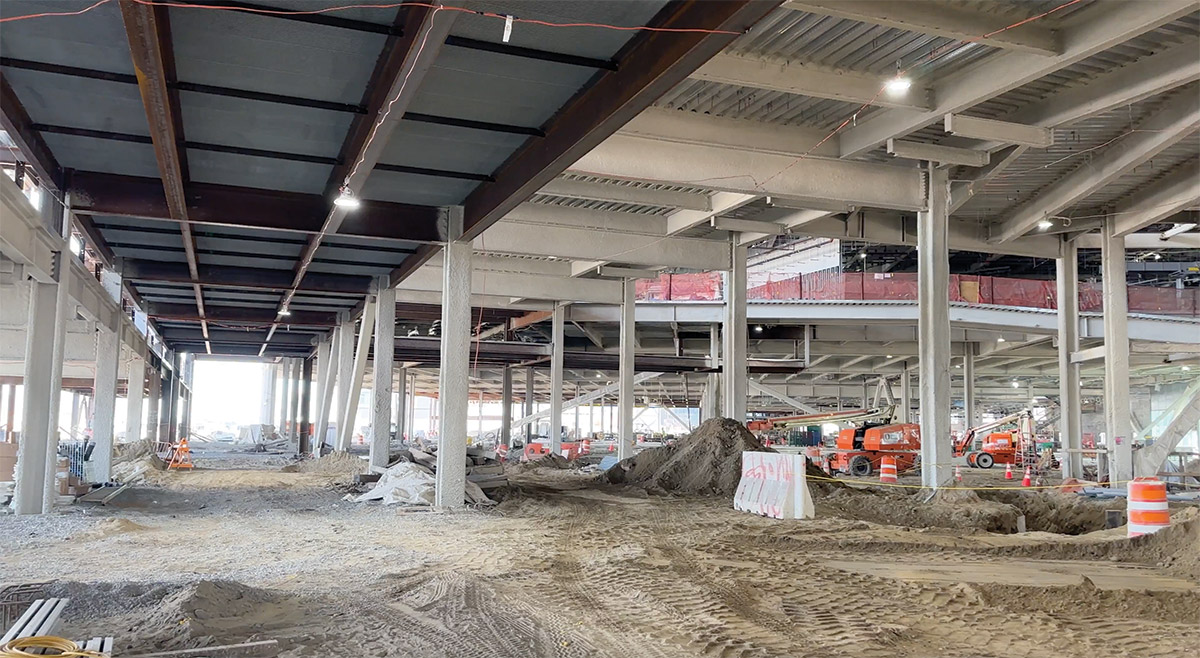
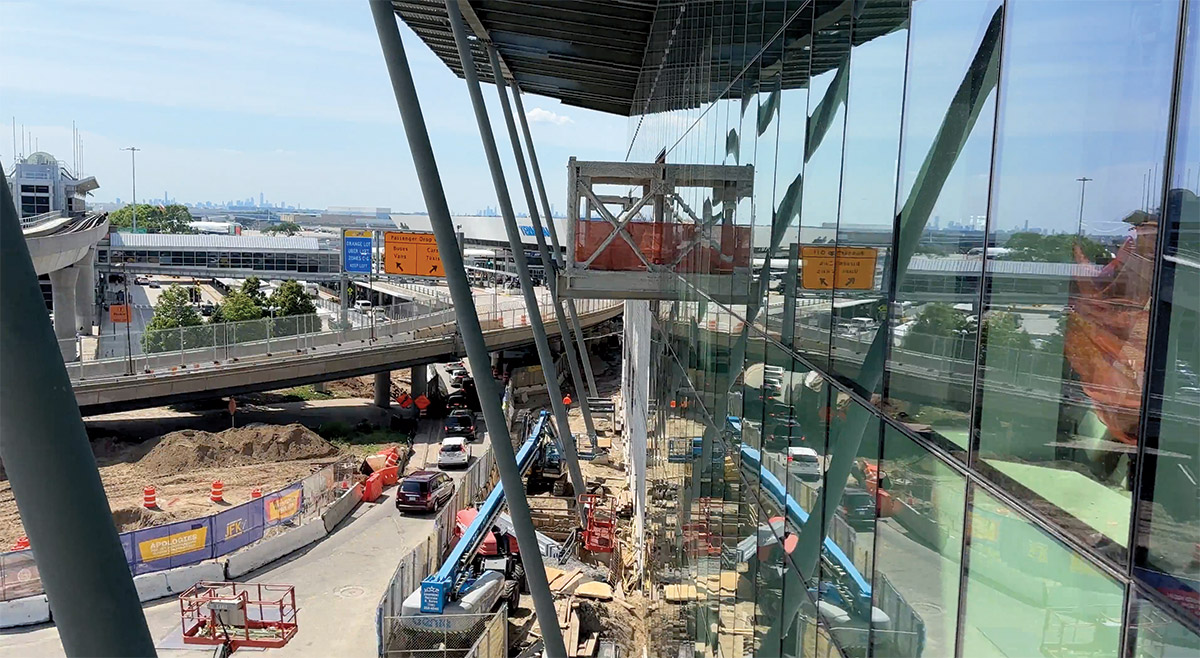
The new Terminal 6 will tie seamlessly into Terminal 5 when complete.
Photos by Scott Blair/ENR
“Now things are motoring ahead,” says Derek Thielmann, vice president of design and construction with Vantage Group, which with American Triple I, RXR Realty and JetBlue constitutes JMP. Vantage Group also was involved with LaGuardia’s Terminal B rebuild. “Traffic was a challenge there, and it’s the same here,” he says, adding that JFK’s larger footprint does help.
Coordination across the entire campus is constant. Since AECOM Tishman is building NTO, “we talk a lot; we share some of the same subs,” says Racky. “We have to be in close coordination to make sure we’re not pouring heavy concrete loads on the same day. Also, there’s the logistics of deliveries. Every day, the roads change.”
All terminal teams coordinate closely with the Skanska-Halmar joint venture building the Roadways, Utilities and Ground Transportation Center project. With Parsons as the designer, the team will untangle the maze of the roadway system with two main loops, and build a multilevel Ground Transportation Center equipped with 1,950 spaces, electric vehicle charging stations and a 400-ft-long elevated pedestrian bridge connecting to NTO. The roof level will feature a rainwater harvesting facility for landscape irrigation and future green roof energy-efficient provisions for solar paneling.
“Our project ties the whole program together,” says David Tullis, project executive with Skanska USA Civil Northeast. Although the team won the $1.24-billion contract last year, “we had been advancing design for a year before that,” he says. “The first few months were spent on permits, access, geotechnical exploration and surveys to verify as-builts.”
Now the team is installing piles, pouring footings and preparing to build foundations for the parking garage, he adds. “It’s a big utility project. We’ll finish the connections for all the terminals, and relocate stuff.” Crews will build a thermal distribution network and stormwater drainage for all the new terminals. The final design items include grading, landscaping and retaining walls. The bridge connecting to NTO is still in design, but will likely be a composite girder bridge with what Tullis says will be a “fancy” canopy—a fitting connection into a parking garage for the NTO, which itself will be quite fancy.

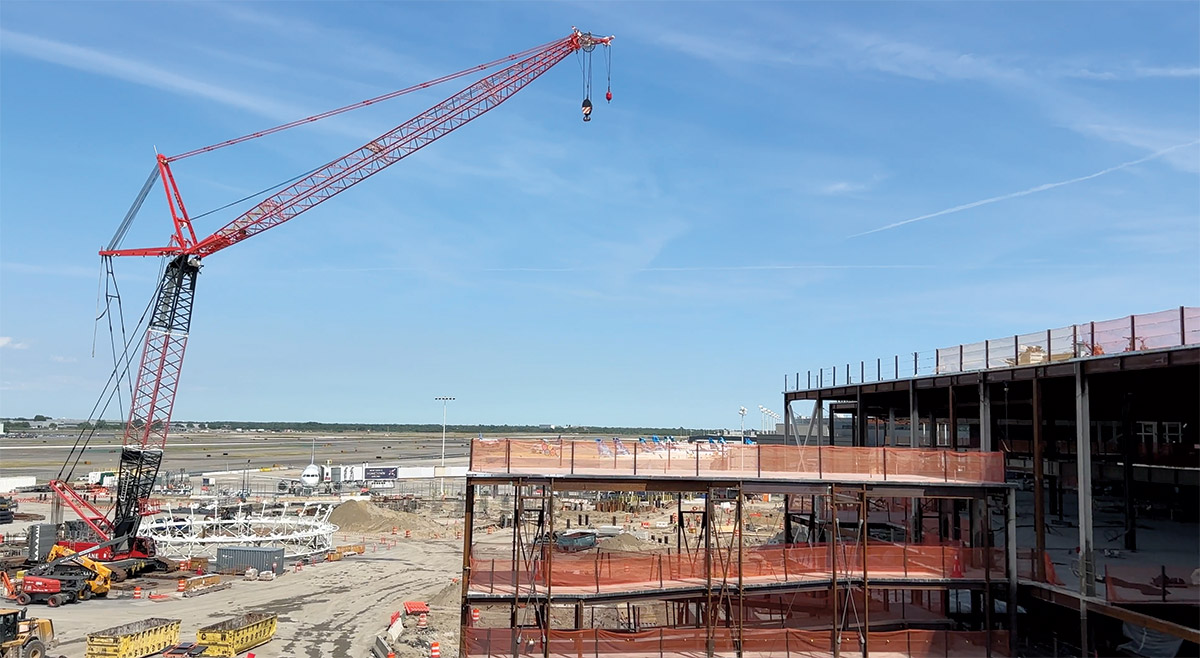
Terminal 6 will have two oculi, 80-ft and 40-ft, providing light and architectural distinction.
Photos by Scott Blair/ENR
Fit for Queens
The restructuring for NTO as crews prepared to break ground in fall of 2022 included Ferrovial coming in to take on a majority stake in the private consortium that includes JLC Infrastructure, Ullico and Carlyle. “Ferrovial brought extensive experience with airports” globally, notes Jennifer Aument, CEO of the NTO consortium.
“We’ve built terminals around the world, but this is different,” says Luke Bugeja, CEO of Ferrovial’s airport division. “No airport terminal in America will look like this. From curbside to gate and visa versa, it will be a totally different experience.”
That’s partly due to NTO being purely an international terminal, says Palmina Whelan, NTO capital program director, “which means it defines the space a little bit differently. We are looking for a pure customer experience ensuring that we meet that world-class standard ... where it’s intuitive, it’s seamless. They come in and they’re immersed into a sense of place.”
International travelers, instead of traveling through enclosed corridors and down to a processing area, will travel across the upper level, immediately exposed to views of the city. “A previous concept was very traditional—you arrive, you go through a sterile corridor and down to Immigration,” says Ty Osbaugh, a global cities sector leader with Gensler, which with AECOM won a design competition for NTO in 2021. “The hindrance was that you’d take a ramp to go under the Airtrain, then ramp back up. We said, instead of navigating that, let’s move the immigration hall to the upper level. It’s a radically different concept. We’re celebrating the arrival experience.”
The NTO will have 300,000 sq ft of amenity spaces, photovoltaic power, and a central roof spine shaped like a bowtie with supporting skylights. There will be a 100-ft transition zone between the building and curbside consisting of greenery— “a garden, not a concrete jungle,” Osbaugh says. The “sawtoothed” staggered, dynamically signed curbside lanes are designed so that taxis and rideshares will use the outer spaces, and family drop-offs—which typically take more time for unloading—will use the inner ones, he adds.
The NTO also is designed to have full biometric capacity. “Our security checkpoint is literally the size of a football field plus,” says Whelan, adding that the 33,000 tons of structural steel for the 1.8-million-square-ft first phase is the equivalent of five Eiffel Towers.
Project officials note the complexities that come from building around Airtrain without touching it. Crews built a 60-ft x 900-ft steel structure and precast envelope around the Airtrain, which was not the only existing infrastructure to deal with. AECOM Tishman’s crews had to manage existing infrastructure while mobilizing, says James Durkin, Tishman senior vice president. “We identified every utility, and built over them while they were in service,” he says, noting that they included 36-in. cooling pipes, 24-in. heating pipes and some 3,000 existing piles, of which some 600 had to be relocated.
New piles are typically tapered tube steel piles as deep as 80 ft through a consistent sand layer, he adds. The team is also reusing some 60,000 cu yd of crushed concrete from a demolished parking garage and the old T2 to elevate the grade of the terminal some 2 ft rather than build a floodwall, he says.
The headhouse’s sweeping spaces are supported by 10 Y-shaped “tree” columns with four “branches” each and 16 columns with two branches each as high as 100 ft, Durkin adds. Each column is clad in glass fiber reinforced polymer and provides 120 ft of clear space.
The team is meeting an accelerated milestone of making the NTO envelope weathertight this summer while beginning MEP work, notes Aument. The first phase, with the headhouse, new departures hall and 14 gates, is on schedule to open in 2026. Once the first phase is complete, the team will start closing old T1 gates in preparation for demolition of the old terminal and for construction of the second phase. The final nine gates are slated to open in 2030.
Aument notes that at peak next year, the NTO site will have some 2,700 workers. “We are looking ahead to procure partners for the operations period,” she adds. As with the construction, that will entail drawing heavily on local communities for talent.
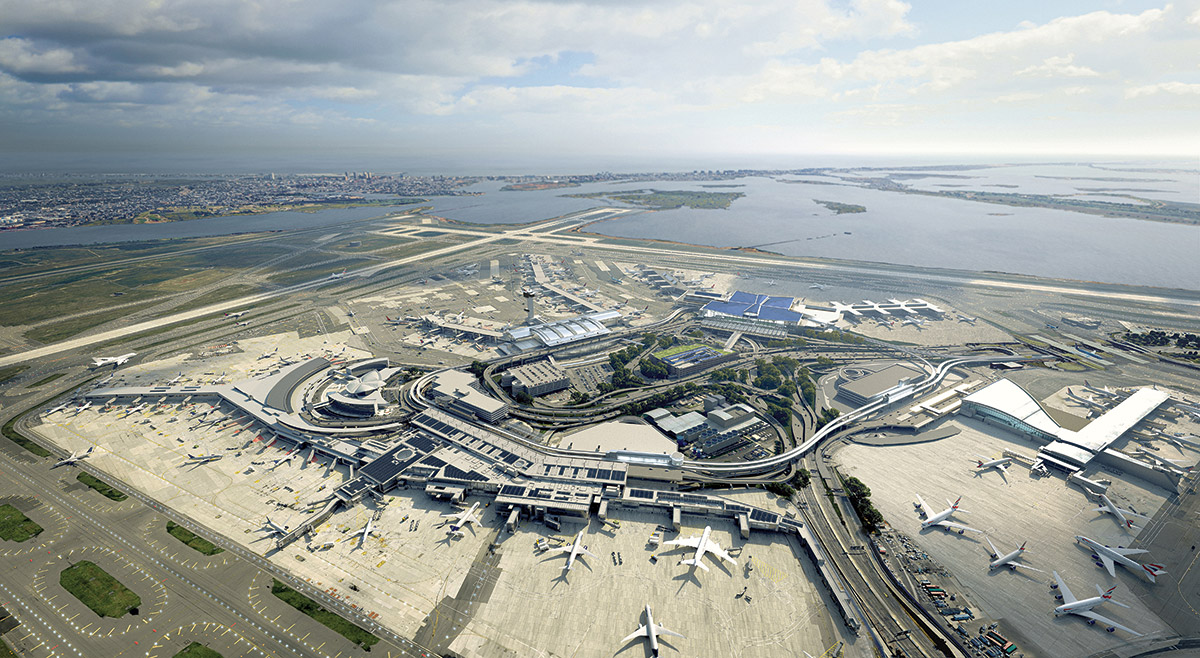
Rendering courtesy PANYNJ
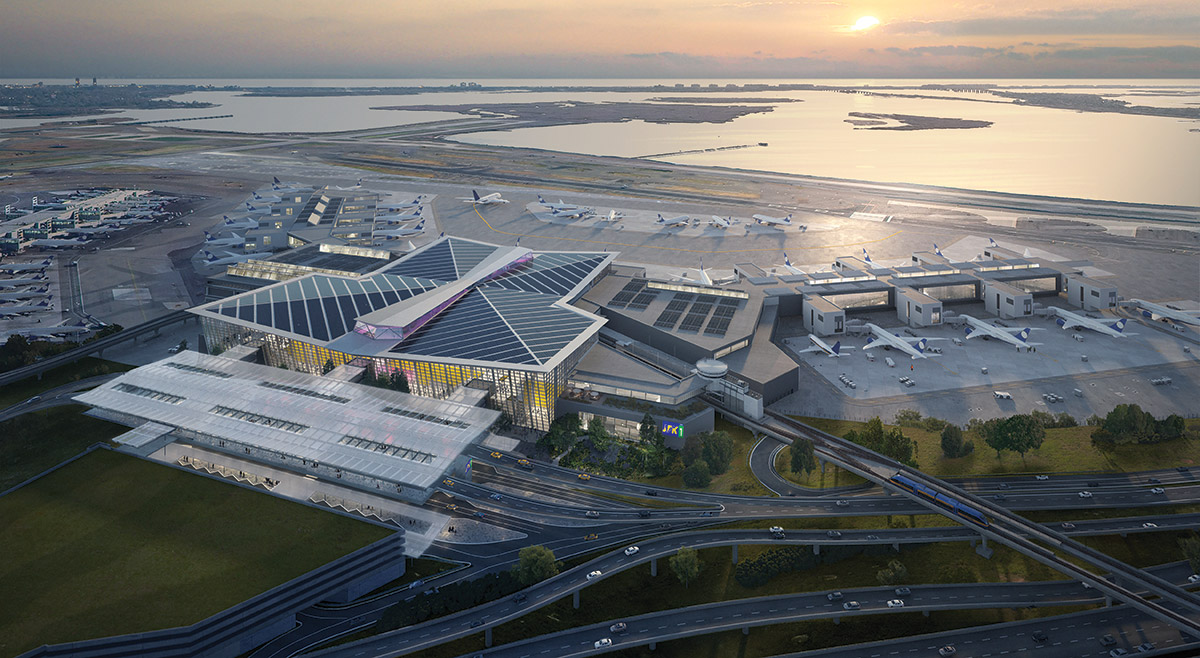
Rendering courtesy of NTO
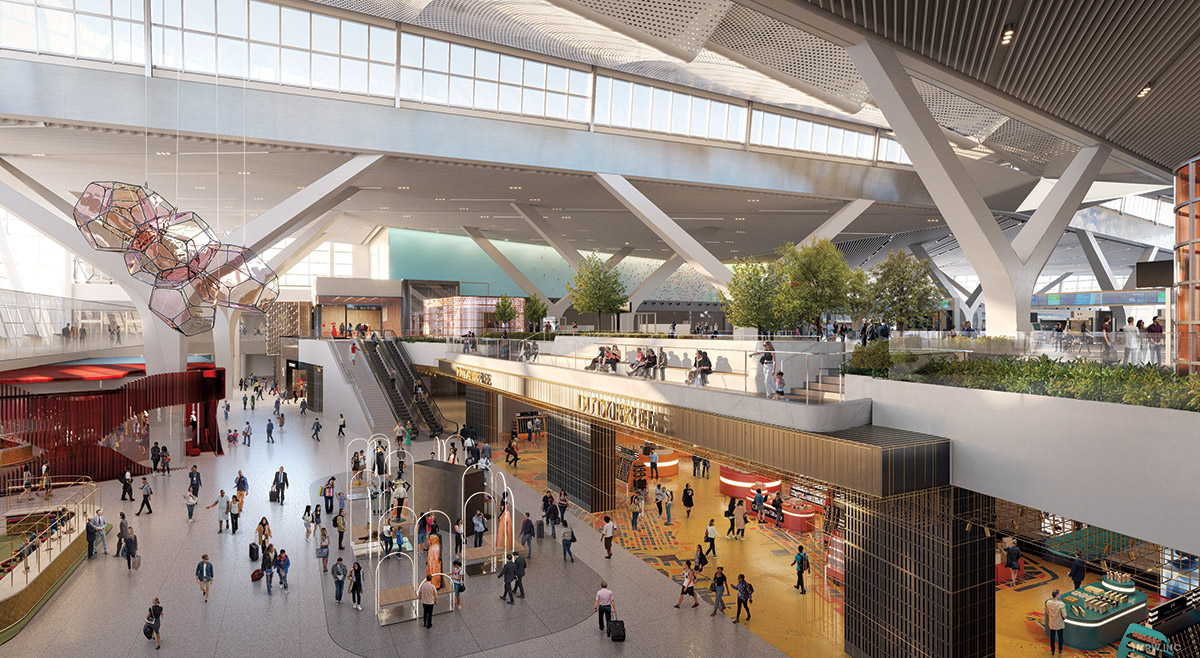
Rendering courtesy The New Terminal One
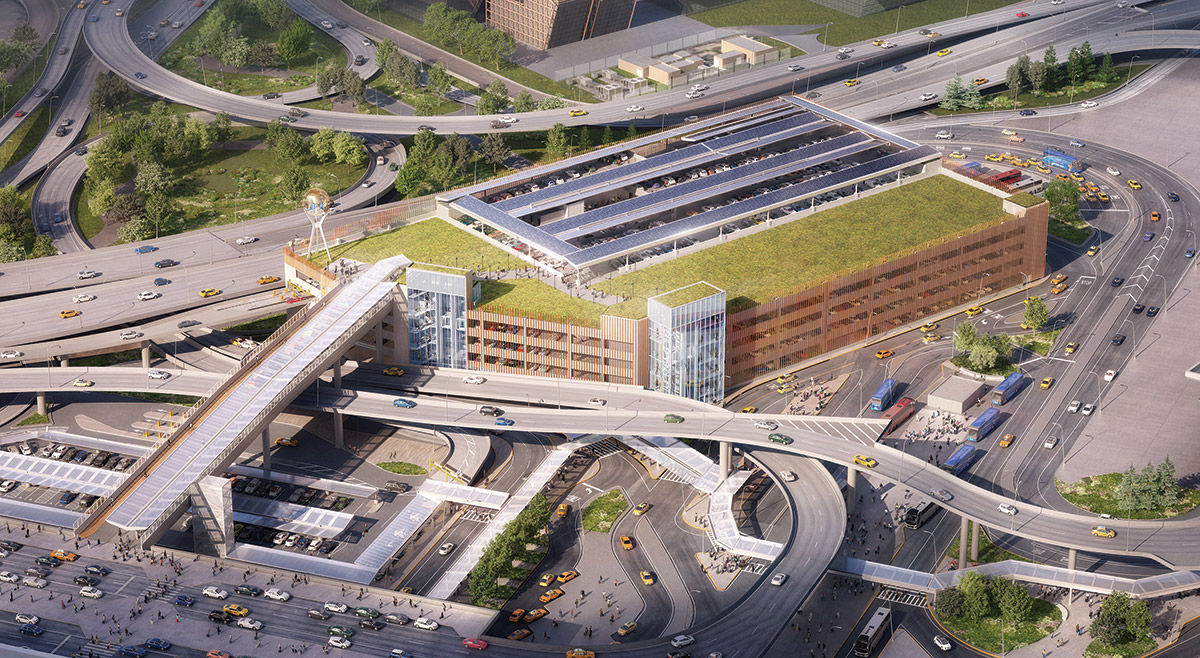
Rendering courtesy Skanska
Diversity Drive
So far, NTO has awarded more than $1.2 billion in contracts for M/WBE and local businesses. “We have stakeholders who are really invested in making sure we not only reach that 30% [port-authority mandated] goal, but that we exceed it,” says Melva Miller, NTO chief of engagement. “Right now, we have about 426 minority- and women-owned businesses on this job, which totals about $1.2 billion in economic impact, and we have about 199 local firms.”
Like other project officials, Miller highlights the synergy of Queens being an exceptionally diverse borough, with international travelers from those New Yorkers’ native lands someday coming through the NTO. “Not only do we get to be the gateway to the world, but the folks who are part of this project are really representative of that world,” she adds.
One of them is Hanson James, a Queens native who graduated from a port authority mentoring program and founded the MBE firm Creative Construction in 2005. “They don’t just talk about it, they pursue it,” the former union carpenter says of the JFK project teams’ commitment to the community.
“They have outreach events every month. They involve elected local officials. And [the NTO team] makes it so easy for small contractors—we get paid quickly. [Even] as a subcontractor, I truly feel like I’m part of the team. It has restored my faith in the industry.”









